Chocolate Swiss Roll

Chocolate Swiss roll is a bit tricky. Why? Because cocoa powder complicates things.
Cocoa powder makes sheet cake less stretchable, so you have to be careful not to overbake the cake. Even slight overbaking makes the cake crack when you roll it.
Cocoa powder also makes the crust sticky, so you have to be careful not to underbake the cake. The more underbaked the crust is, the stickier it is.
The cake is perfectly done when it just turns springy in the middle. After cooling down, the crust should be a bit sticky around the edges.
That’s OK because the ends will be trimmed, or tucked inside/below after the cake is rolled.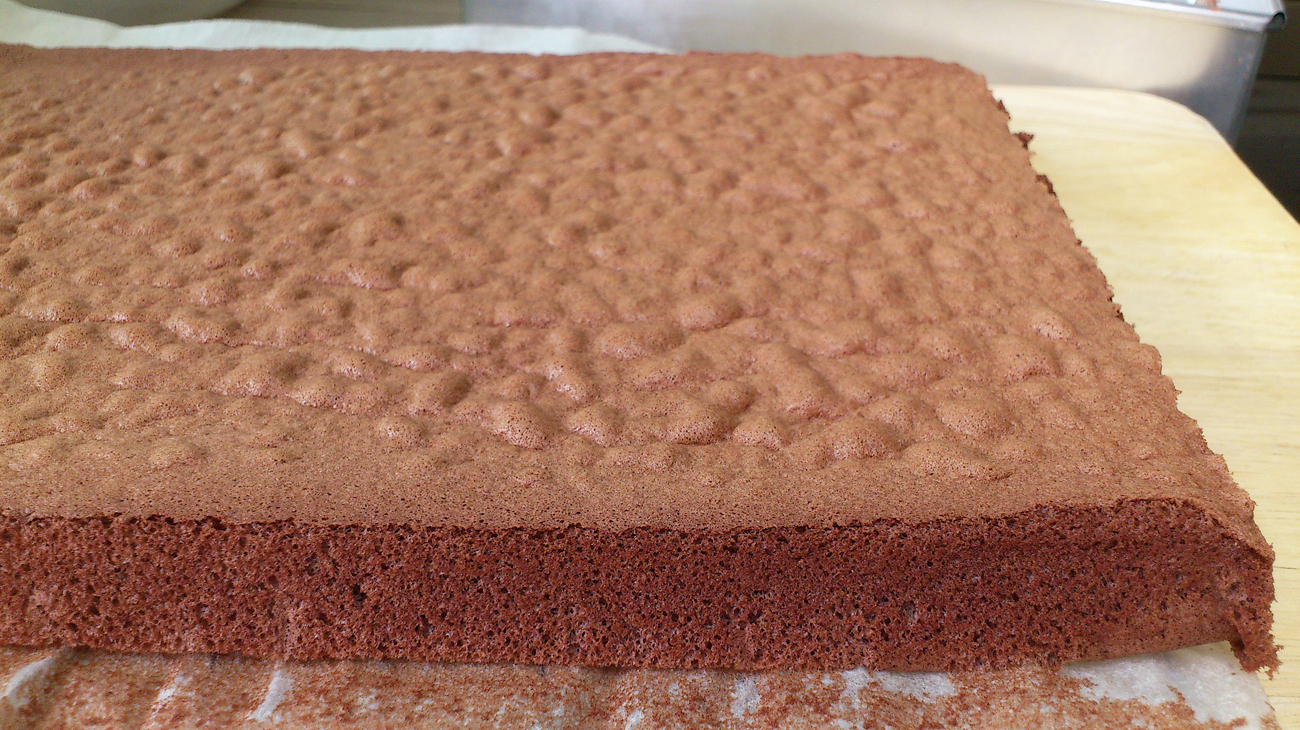
If the entire crust isn’t sticky, that’s not a good thing at all. The cake is too dry and will likely crack when you roll it.
If the entire crust is sticky, it’s gonna stick to whatever it rests on. Of course, that’s not a problem if you ice the cake. Or if you go for the skinless look and roll the cake inside out.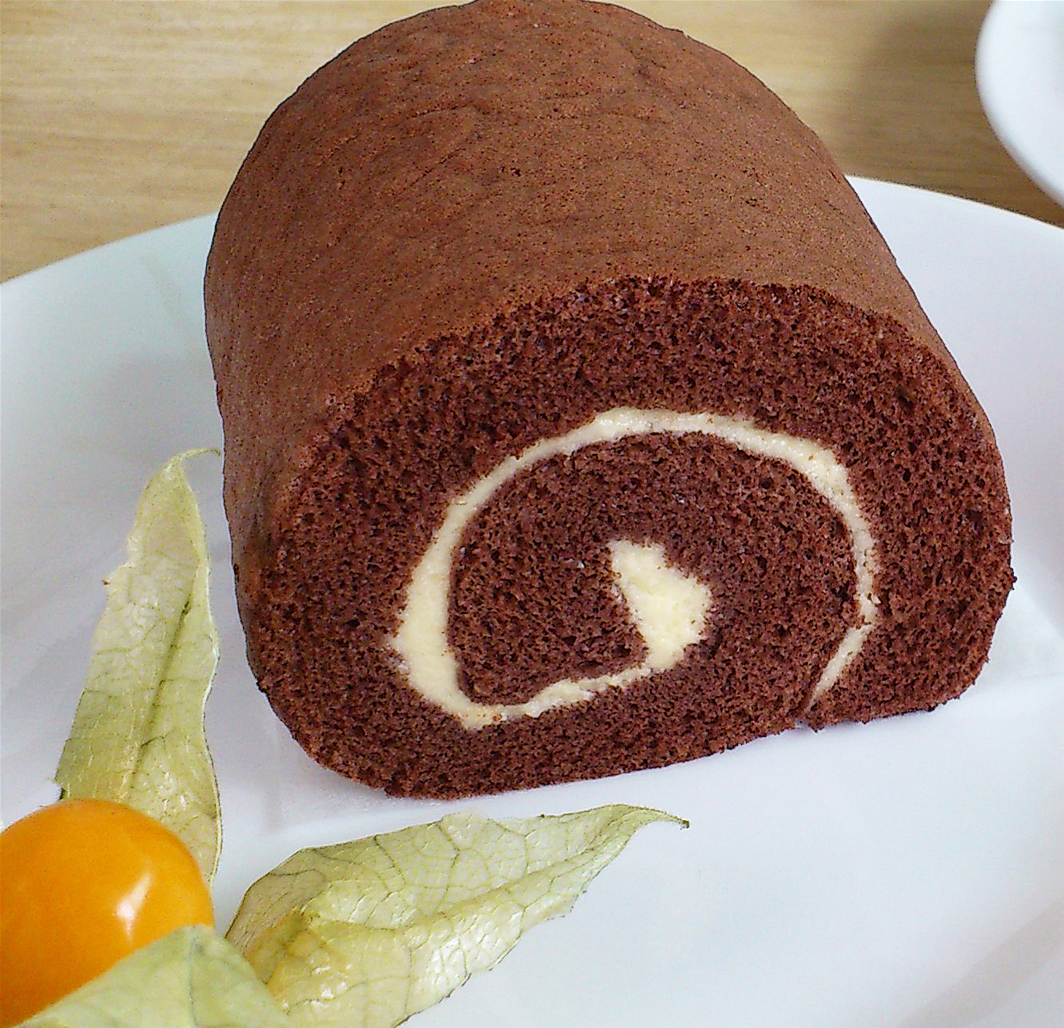
Even when you’ve got the cake baked just right, you may still have a problem when you’re rolling the cake. Why? Because the crust doesn’t really stick to the crumb, so it comes off very easily. The loose crust is caused by cocoa powder which, as I said, complicates things.
Chocolate cakes have haphephobia (fear of being touched). Direct contact with the crust must be minimized if you don’t want to damage it. How? Like this:
Put the cake on a piece of parchment paper, crust side down. Spread with whatever filling you like. 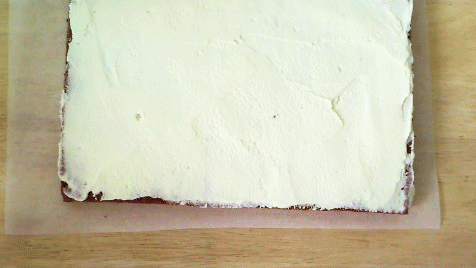
Start rolling the cake by making a fold in the cake. The fold must be very small, or the cake will be oval instead of round after it’s rolled.
After the first fold is tucked in tightly, lift and tilt the parchment paper with your left hand (if you’re right-handed). As the cake moves forward, it may bulge here and there. Gently flatten the bulges with your right hand so that the roll is tight and even. If you’re making a very long roll, you’d need a rolling pin (or the core of your parchment paper or aluminium foil) to do this.
Because the cake doesn’t handle well, it cracks (when you roll it) if it’s too thick. And if it’s too thin, the inside may be too dry when the crust is just right. Hence, you must scale the recipe according to your pan size. You don’t want too little or too much batter in the pan. 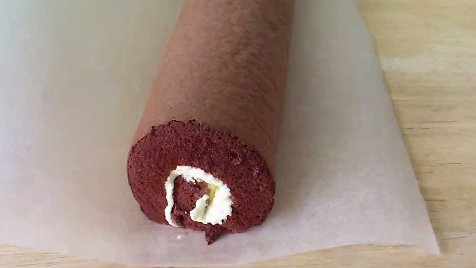
Why make such a fuss over a cake? Why not just let it crack? You can hide the cracks with icing, icing sugar, chocolate rice/shavings, nuts, whatever. Nobody would know, right?
Yup, covering up is an easy way out. But you’d have bought a chocolate Swiss roll if you had wanted the easy way out. Or at least made a Swiss roll without cocoa powder. Or just eat the cake without rolling it!
If you want to make a less challenging Swiss roll, click here for my vanilla recipe. Matcha Swiss roll is also pretty straightforward.
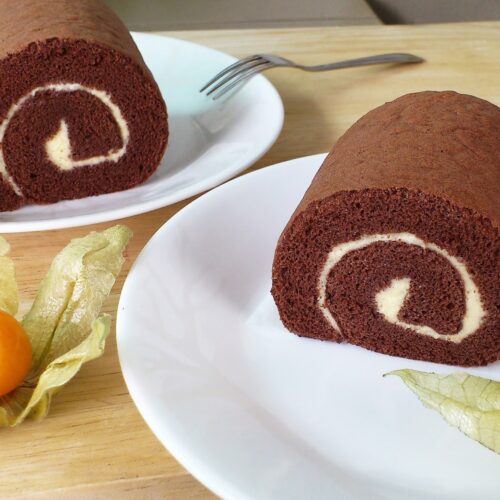
Chocolate Swiss Roll
Ingredients
- 15 g corn oil
- 10 g alkalized cocoa powder
- 15 g castor sugar
- 10 g water
- 1 pinch salt
- 1/2 tsp vanilla extract
- 30 g egg yolks
- 15 g cake flour
- 70 g egg whites
- 30 g castor sugar
- 75 g whipped cream
Instructions
- To make cake, preheat oven to 200°C. Measure and prep ingredients as detailed above. Grease 12″ x 9″ pan with butter. Line pan with 12″ x 12″ parchment paper.
- Heat oil till hot but not smoking (if you put your hand near the oil, you should feel searing heat). Add to cocoa powder. Whisk thoroughly. Add 15 g castor sugar. Whisk thoroughly. Add water. Whisk till thick paste forms. Add salt, vanilla extract and egg yolks. Whisk till sugar dissolves. Sift half of cake flour into mixture. Mix with whisk till even. Sift remaining cake flour into mixture. Mix with whisk till even.15 g corn oil, 10 g alkalized cocoa powder, 15 g castor sugar, 10 g water, 1 pinch salt, 1/2 tsp vanilla extract, 30 g egg yolks, 15 g cake flour
- Whisk egg whites on medium-slow speed till thick foam forms. Gradually add 30 g castor sugar whilst continuing to whisk. Keep whisking till egg whites are at soft peak stage. Reduce speed to slow and continue to whisk till firm peak stage (when whisk is lifted, egg whites form peak that’s hooked).70 g egg whites, 30 g castor sugar
- Loosen egg yolk mixture from bottom of mixing bowl with whisk. Add egg whites in 2 batches. Mix with whisk after each addition till batter looks even. Scrape down and fold with spatula till batter is truly even.
- Pour batter into cake pan. Spread with spatula as evenly as possible, pushing batter into corners of pan. Jiggle vigorously till batter is level. Tap pan against worktop twice.
- Bake cake on middle shelf till middle of cake is springy when pressed, about 10 minutes. Remove from oven. Drop pan from 1′ high 3-4 times. Unmould cake onto wire rack. Peel parchment paper from sides of cake. Leave till cool.
- To assemble Swiss roll, place cake on clean parchment paper, crust side down. Peel parchment paper from bottom of cake. Spread evenly with whipped cream. Roll cake as shown in video. Do not remove parchment paper till cake is transferred to serving plate (so that cake may be moved easily without touching the crust).75 g whipped cream
- To cut neatly, chill Swiss roll till filling is set. Cut with serrated knife, wiping knife clean with paper towels after each cut. Transfer to serving plate. Discard parchment paper.
- To store overnight, place Swiss roll in cake pan. Place pan in plastic bag, making sure bag doesn’t touch Swiss roll. Refrigerate. Remove from fridge about 15 minutes before serving. Cut immediately. Transfer to serving plate. Discard parchment paper. Serve when cake is soft but filling is still cold.